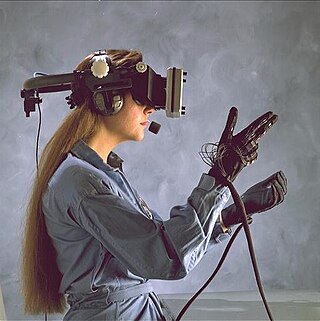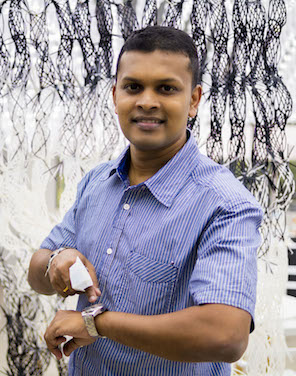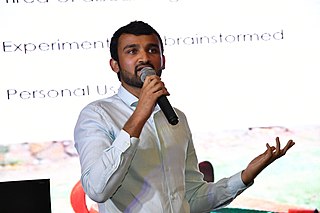Related Research Articles

Nicholas Negroponte is a Greek American architect. He is the founder and chairman Emeritus of Massachusetts Institute of Technology's Media Lab, and also founded the One Laptop per Child Association (OLPC). Negroponte is the author of the 1995 bestseller Being Digital translated into more than forty languages.

Haptic technology is technology that can create an experience of touch by applying forces, vibrations, or motions to the user. These technologies can be used to create virtual objects in a computer simulation, to control virtual objects, and to enhance remote control of machines and devices (telerobotics). Haptic devices may incorporate tactile sensors that measure forces exerted by the user on the interface. The word haptic, from the Greek: ἁπτικός (haptikos), means "tactile, pertaining to the sense of touch". Simple haptic devices are common in the form of game controllers, joysticks, and steering wheels.

The MIT Media Lab is a research laboratory at the Massachusetts Institute of Technology, growing out of MIT's Architecture Machine Group in the School of Architecture. Its research does not restrict to fixed academic disciplines, but draws from technology, media, science, art, and design. As of 2014, Media lab's research groups include neurobiology, biologically inspired fabrication, socially engaging robots, emotive computing, bionics, and hyperinstruments.

Nashik, Marathi: [naːʃik], formerly Nasik(listen)), is a city in the northern region of the Indian state of Maharashtra. Situated on the banks of the river Godavari, Nashik is the fourth largest city in Maharashtra after Mumbai, Pune and Nagpur. The population of Nashik city is around 22 lakhs and is emerging as one of the fastest-growing cities in India. Nashik is located about 165 km northeast of the state capital Mumbai, and about 210 km north from Pune. The Mumbai-Pune-Nashik region is called the "Golden Triangle of Maharashtra". With its high agricultural production, Nashik is dubbed the Napa Valley of India and the "Wine Capital of India" as more than half of India's vineyards and wineries are located here. Around 90% of all Indian wine comes from the Nashik Valley. Nashik is well known for being one of the Hindu pilgrimage sites of the Kumbh Mela, which is held every 12 years.It has been a major industrial center in automobile hub. The city houses companies like Exxelia, Atlas Copco, Robert Bosch GmbH, CEAT Limited, Crompton Greaves, Graphite India, ThyssenKrupp, Epcos, Everest Industries, Gabriel India, GlaxoSmithKline, Hindustan Coca-Cola, Hindustan Unilever Limited, Jindal Polyster, Jyoti Structures, Kirloskar Oil Engines, KSB Pumps, Larsen & Toubro, Mahindra and Mahindra, Mahindra Sona, United Spirits Limited, Perfect Circle Industries, Mahindra Ugine Steel, Samsonite, Shalimar Paints, Siemens, VIP Industries, Indian Oil Corporation, XLO India Limited and Jindal Saw, among others.
Ambient devices are a type of consumer electronics, characterized by their ability to be perceived at-a-glance, also known as "glanceable". Ambient devices use pre-attentive processing to display information and are aimed at minimizing mental effort. Associated fields include ubiquitous computing and calm technology. The concept is closely related to the Internet of Things.
Rahul Sarpeshkar is the Thomas E. Kurtz Professor and a professor of engineering, professor of physics, professor of microbiology & immunology, and professor of molecular and systems biology at Dartmouth. Sarpeshkar, whose interdisciplinary work is in bioengineering, electrical engineering, quantum physics, and biophysics, is the inaugural chair of the William H. Neukom cluster of computational science, which focuses on analog, quantum, and biological computation. The clusters, designed by faculty from across the institution to address major global challenges, are part of President Philip Hanlon's vision for strengthening academic excellence at Dartmouth. Prior to Dartmouth, Sarpeshkar was a tenured professor at the Massachusetts Institute of Technology and led the Analog Circuits and Biological Systems Group. He is now also a visiting scientist at MIT's Research Laboratory of Electronics.

Mark McLachlan born February 27, 1990, is a product and game designer. Mark has designed and released products under the scope of the product design and game publishing studio Antsy Labs. In collaboration with his brother, Matthew McLachlan, Mark invented the Fidget Cube, the second most-backed Kickstarter campaign in history.
A three-dimensional integrated circuit is a MOS integrated circuit (IC) manufactured by stacking as many as 16 or more ICs and interconnecting them vertically using, for instance, through-silicon vias (TSVs) or Cu-Cu connections, so that they behave as a single device to achieve performance improvements at reduced power and smaller footprint than conventional two dimensional processes. The 3D IC is one of several 3D integration schemes that exploit the z-direction to achieve electrical performance benefits in microelectronics and nanoelectronics.

Lakshmi Pratury is an entrepreneur, curator, and speaker. She is the founder and CEO of INK. She also is the host and curator of live events and inktalks.com.

Krisztina Holly, known by her colleagues as 'Z', is a Hungarian American innovator, entrepreneur, and adventurer.
Param Jaggi is an American inventor and the CEO of Hatch Technologies. Previously, he was founder and CEO of EcoViate. He is known for building Algae Mobile, a device that converts carbon dioxide emitted from a car into oxygen. Jaggi was featured in Forbes 30 under 30 in 2011 and 2012.

Suranga Nanayakkara is a Sri Lankan born computer scientist and inventor. As of 2021, he is the director of Augmented Human Lab and associate professor at the National University of Singapore. Before moving to Auckland in 2018, he was an assistant professor at Singapore University of Technology and Design. He is best known for his work on FingerReader and Haptic Chair. His research interests include Wearable Computing, Assistive Technology, Ubiquitous computing, AI, Collective intelligence and Robotics. MIT Technology Review honored Nanayakkara as one of the Innovators Under 35 for Asia Pacific Region 2014.

John Werner is the founder of Ideas in Action, Inc. (IIA) and Managing Director at Link Ventures. Prior he was a Vice President at an augmented reality company. He is also founding Managing Director for MIT Media Lab's Emerging Worlds Special Interest Group (SIG), and former Head of Innovation and New Ventures for the Camera Culture Group at the MIT Media Lab for Ramesh Raskar, director of the Camera Culture Group at MIT Media Lab. He is one of the founding members of the non-profit organization Citizen Schools and the curator of TEDxBeaconStreet, and TEDxMIT with Daniela Rus - both independent event licensed by TED as part of TEDx. He started first ever AR-in-Action Augmented Reality Conference "ARIA" at MIT Media Lab in January 2017 and Blockchain+AI+Human = Magic Summit, now called Imagination in Action at MIT and Davos which he curates with Professor Sandy Pentland.

Sunil Shivaji Khandbahale is a MIT Sloan Fellow, Innovator and Entrepreneur from Nashik, India. He is the founder and CEO of KHANDBAHALE.COM, a free multilingual digital dictionary and translation platform for 23 languages, with a vocabulary of 10 million words and phrases. He is a regular technology and innovation columnist for national and international media.
Jay Saul Silver is an electrical engineer and toy inventor from Cocoa Beach, Florida. Silver is the Founder and CEO of JoyLabz and MaKey MaKey and was the first-ever Maker Research Scientist at Intel.

Makey Makey: An Invention Kit for Everyone is an invention kit designed to connect everyday objects to computer keys. Using a circuit board, alligator clips, and a USB cable, the toy uses closed loop electrical signals to send the computer either a keyboard stroke or mouse click signal. This function allows the Makey Makey to work with any computer program or webpage that accepts keyboard or mouse click.

The Fidget Cube is a small hand-held device designed by Matthew and Mark McLachlan, brothers and co-founders of the Colorado-based design studio Antsy Labs. It has fidget tools on all sides: a switch, gears, a rolling ball (marble), a joystick, a spinning disk, a worry stone, and five buttons. It may help users with ADHD focus.
Carol Elizabeth Reiley is an American business executive, computer scientist, and model. She is a pioneer in teleoperated and autonomous robot systems in surgery, space exploration, disaster rescue, and self-driving cars. Reiley has worked at Intuitive Surgical, Lockheed Martin, and General Electric. She co-founded, invested in, and was president of Drive.ai, and is now CEO of a healthcare startup, a creative advisor for the San Francisco Symphony, and a brand ambassador for Guerlain Cosmetics. She is a published children's book author, the first female engineer on the cover of MAKE magazine, and is ranked by Forbes, Inc, and Quartz as a leading entrepreneur and influential scientist.

Star Simpson is a prominent maker, inventor, and serial entrepreneur based in Los Angeles. She is responsible for a number of high-profile projects with drone design and applications, including developing autonomous aircraft for DARPA at Otherlab, a Research & Development lab in San Francisco.

Shriyans Bhandari is an Indian social entrepreneur, author and co-founder of Greensole.
References
- ↑ "Dhairya Dand". TEDxHamburg.
- ↑ "Advisory Board, Women's Safety XPrize". XPrize.
- ↑ "Dhairya Dand LinkedIn Page". LinkedIn. Retrieved January 3, 2017.
- ↑ "Dhairya Dand: Moved by stories, driven by curiosities". DNA . November 15, 2015.
- ↑ "Dhairya Dand's journey from Nashik to MIT Media Lab a dedication to hard work". The Economic Times . May 7, 2014.
- ↑ "Dhairya Dand: Blending imagination and reality". Forbes India.
- ↑ "Dhairya Dand: Moved by stories, driven by curiosities". DNA. November 15, 2015.
- ↑ "Brand Equity: In Conversation With MIT Media Labs' Dhairya Dand & Deepak Jagdish". ET Now.
- ↑ "MIT's Vibrating Supershoes Tell You Where To Walk". Fast Company .
- ↑ "Toe-Tickling Shoes Let You Navigate the City by Touch". Popular Science . April 25, 2014.
- ↑ "The High-Tech Shoes That 'Tickle' You Directions". The Atlantic . April 23, 2014.
- ↑ "SuperShoes tickle your toes to help you find your way". New Atlas. April 23, 2014.
- ↑ "'Love, See, Do. Repeat', Dhairya Dand". TEDx Hamburg.
- ↑ "'Obake' (o-baa-keh) – 2.5D interaction gestures to manipulate 3D surfaces". Creative Applications. April 9, 2013.
- ↑ "3D? Whatev! Obake Is A "2.5D" Elasticated Touch Screen Display". The Creator's Project. April 18, 2013.
- ↑ "A New Computer Screen Reaches Out to Touch You". MIT Technology Review .
- ↑ "A Touchscreen You Can Pinch, Poke and Stretch". Mashable. April 24, 2013.
- ↑ "Elastic touchscreen prototype lets you pinch and zoom in '2.5D'". The Verge . April 18, 2013.
- ↑ "Gestures for sharing data between devices in close physical proximity". USPTO.
- ↑ "MIT Student Invents LED Ice Cubes That Track How Much You've Been Drinking". Time .
- ↑ "MIT Student Invents LED Ice Cubes to Track Alcohol Intake". ABC News.
- ↑ "Too much to drink? Ice cube can tell you". CNN. January 18, 2013.
- ↑ "Glowing Ice Cubes Warn You When You Drink Too Much". Popular Science. January 12, 2013.
- ↑ "Dhairya Dand: Blending imagination and reality". Forbes India.
- ↑ "ThinkerToys repurpose old keyboards, mice, and monitors into educational toys". The Verge. April 2012.
- ↑ "Thinkertoys Turn E-Waste into Fun Gadgetry". Make .
- ↑ "Using e-waste to create educational toys, with ThinkerToys". New Atlas. March 28, 2012.
- ↑ "Dhairya Dand: Moved by stories, driven by curiosities". DNA. November 15, 2015.
- ↑ "Dhairya Dand's journey from Nashik to MIT Media Lab a dedication to hard work". The Economic Times. May 7, 2014.
- ↑ "Enablers for the Disabled" (PDF). The Times of India . Retrieved January 2, 2017– via Dropbox.
- ↑ "Media Consumption Device Lets You Flip and Shake to Alter News Perspectives". PSFK.
- ↑ "Forbes 30 under 30 list 2015". Forbes India .
- ↑ "Forbes 30 under 30 list 2016". Forbes.
- ↑ "Future of Storytelling". Archived from the original on November 8, 2015. Retrieved December 21, 2016.
- ↑ "20 names to know for 2015" (PDF). Elle . Retrieved January 2, 2017.
- ↑ "Vogue 2015: Tribes of Cool". Vogue . October 29, 2015.
- ↑ "Meet the inaugural Wired Innovation Fellows". Wired UK .
- ↑ "INK2014: The INK Fellowship". INK Talks.
- ↑ "People's Choice Design Award". Smithsonian .
- ↑ "The Hive 25 under 25". The Boston Globe.
- ↑ "What is the future?". Tencent.
- ↑ "Speakers" (PDF). Tokyo Designers Week. Retrieved January 2, 2017.
- ↑ "Wired 2014, Dhairya Dand". Wired UK.
- ↑ "INK 2014, Speakers". INK Talks.
- ↑ "'Love, See, Do. Repeat', Dhairya Dand". TEDx Hamburg.
- ↑ "TED". TED. October 18, 2018.
- ↑ "FutureFlash". ICA.
- ↑ "Creating SuperShoes: Dhairya Dand at K12Live! (MIT Museum Second Fridays, 1-10-14)". MIT Museum.
- ↑ "Shoes: Pleasure and Pain". Victoria and Albert Museum.
- ↑ Dand, Dhairya (2013). "Obake". Proceedings of the adjunct publication of the 26th annual ACM symposium on User interface software and technology - UIST '13 Adjunct. pp. 109–110. doi:10.1145/2508468.2514734. ISBN 978-1-4503-2406-9. S2CID 41435030 . Retrieved January 3, 2017.
- ↑ Dand, Dhairya (2013). "What's cookin?: A platform for remote collaboration". CHI '13 Extended Abstracts on Human Factors in Computing Systems. pp. 2799–2800. doi:10.1145/2468356.2479518. ISBN 978-1-4503-1952-2. S2CID 8487791 . Retrieved January 3, 2017.
- ↑ Dand, Dhairya (2013). "Cheers: Alcohol-aware strobing ice cubes". CHI '13 Extended Abstracts on Human Factors in Computing Systems. pp. 2795–2796. doi:10.1145/2468356.2479516. ISBN 978-1-4503-1952-2. S2CID 13185637 . Retrieved January 3, 2017.